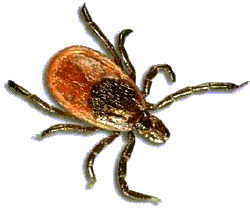| PITTSBORO
- The art and science of medicine are not always straightforward,
as indicated by the N.C. Medical Board hearing on Dr. Joseph
Jemsek this month. The Medical Board charged the Mecklenburg
County physician with improperly diagnosing tick-borne infections
and violating medical standards by treating patients with
prolonged doses of intravenous antibiotics. The board suspended
Jemsek's license.
The
hearing, which I observed, was useful in a number of ways.
First, it is important for patients and the medical profession
to understand that the diagnosis and treatment of tick-borne
diseases, including Lyme disease, is not always easy.
Tests for Lyme disease perform poorly. A 2005 study from
Johns Hopkins found "no single test, including culture
from plasma or skin, achieves a high rate of diagnostic
sensitivity." The researchers went on to combine
various tests to see how much that could improve accuracy.
Even then, the combination for a "relatively rapid
alternative" still missed 25 percent of acute cases.
Second,
the diagnosis of all tick-borne infections must be clinical,
especially in the acute phase when delay can lead to death
or permanent impairment. Even though the CDC stresses
this for tick-borne infections, including Lyme disease,
medical providers can forget it, to the detriment of their
patients. Laboratory tests are supportive but cannot be
relied upon for diagnosis. Co-infections such as babesiosis
and bartonella are common, and tests for them perform
poorly as well.
Third,
many people with acute Lyme disease either do not develop
the classic rash, erythema migrans, or do not notice it.
The term "bull's eye" is a misnomer since many
of the rashes are solid red. Persons with tick exposure
and symptoms suggestive of Lyme disease and no history
of a rash cannot be assumed not to have Lyme disease.
Fourth,
because treatment of Lyme disease is controversial and
two standards of care exist, patients should sign a detailed
informed consent form. One standard is from the Infectious
Disease Society of America, the other from the International
Lyme and Associated Diseases Society. All physicians who
treat Lyme disease, regardless of their approach, should
present the two standards of care to patients so they
can be fully informed.
Fifth,
late-stage Lyme disease, like its cousin syphilis, cannot
always be treated successfully, because the disease is
too entrenched, because necessary drugs have not yet been
discovered or because not enough is known about treatment.
These patients may become disgruntled. Unhappy and even
harmed patients occur in many areas of medicine, even
when physicians are doing their best. This is tragic and
needs to be recognized by patients and be part of the
informed consent process.
Sixth,
we learned that tick-borne infections, including Lyme
disease, are a considerable problem in this state. The
public health system needs to do more.
Lyme
disease in particular is controversial, in part due to
the lack of reliable tests not only for diagnosis but
to tell if the patient has been cured. Initial signs of
infection often go away for a while, just as with syphilis,
and then return in the often debilitating form of chronic
Lyme disease. Both are caused by a spirochete, a corkscrew-shaped
bacteria that screws its way into muscles, organs, connective
tissues and the nervous system. It can cause damage over
a lifetime that usually involves the brain if not promptly
treated.
Controversy
surrounded the manifestations and treatment of syphilis
in the early days. As with that disease 80 or so years
ago and HIV/AIDS 30 years ago, I believe we are in the
early days of recognizing the full extent of the harm
caused by the Lyme disease spirochete, Borrelia burgdorferi,
or of knowing how to diagnose and treat it.
Meanwhile,
doctors like Jemsek do what they can to help desperately
ill patients who have been misdiagnosed or abandoned.
Other doctors disagree with his diagnoses and treatments
and may tell these patients, often in great pain and with
migrating debilitating symptoms, that they have conditions
such as auto-immune disorders, fibromyalgia or mental
illness. No doubt this is true for some. Or, as one of
the state's witnesses said, their doctors may tell them
that they can't do anything for them. Those with likely
tick-borne infections need treatment nonetheless.
Time
will tell which approach is correct and does the greatest
good for the affected people. Perhaps a new approach is
needed. In the meantime, the public, and medical professionals
especially, need to keep an open mind and recognize that
we are in the early stages of understanding Lyme disease,
co-infections and other emerging tick-borne infections.
Marcia
E. Herman-Giddens holds a doctoral degree in pharmacy.
She is an adjunct professor at the UNC School of Public
Health and president of the Tick-borne Infections Council
of N.C
|
